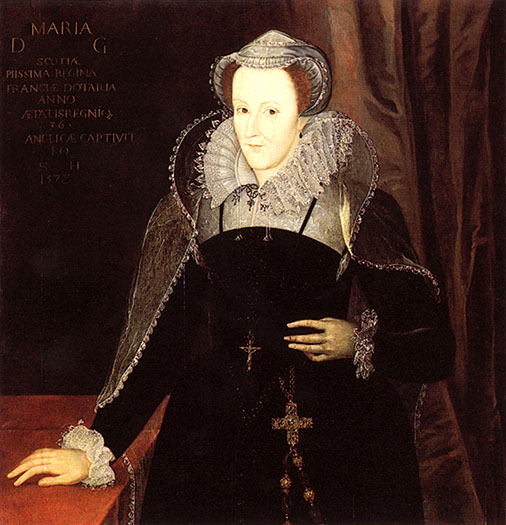

|
Queen of Scotland and France The following text is © by Lara Eakins and is reproduced here by gracious permission for our Guild's historical and educational purposes. The scanned images and documentation are also the work of Lara. BORN: 8 DECEMBER 1542
Daughter of James V of Scotland and Marie de Guise. Became Queen
of Scots when
THE EXECUTION OF MARY QUEEN OF SCOTS
Her prayers being ended, the executioners, kneeling, desired her Grace to forgive then her death: who answered, ‘I forgive you with all my heart, for now, I hope, you shall make an end of all my troubles.’ Then they, with her two women, helping her up, began to disrobe her of her apparel: then she, laying her crucifix upon the stool, one of the executioners took from her neck the Agnus Dei, which she, laying hands off it, gave to one of her women, and told the executioner, he should be answered money for it. Then she suffered them, with her two women, to disrobe her of her chain of pomander beads and all other apparel most willingly, and with joy rather than sorrow, helped to make unready herself, putting on a pair of sleeves with her own hands which they had pulled off, and that with some haste, as if she had longed to be gone. All this time they were pulling off her apparel, she never changed her countenance, but with smiling cheer she uttered these words,’that she never had such grooms to make her unready, and that she never put off her clothes before such a company.’
Then she, being stripped of all her apparel saving her petticoat and kirtle, her two women beholding her made great lamentation, and crying and crossing themselves prayed in Latin. She, turning herself to them, embracing them, said these words in French, ‘Ne crie vous, j’ay prome pour vous’, and so crossing and kissing them, bad them pray for her and rejoice and not weep, for that now they should see an end of all their mistress’s troubles. Then she, with a smiling countenance, turning to her men servants,
as Melvin and the rest, standing upon a bench nigh the scaffold, who sometime
weeping, sometime crying out aloud, and continually crossing themselves,
prayed in Latin, crossing them with her hand bade them farewell, and wishing
them to pray for her even until the last hour.

Mary in 1578 After Nicolas Hilliard (possibly a 17th century copy) National Portrait Gallery, London Then Mr. Dean [Dr. Fletcher, Dean of Peterborough] said with a loud voice, ‘So perish all the Queen’s enemies’, and afterwards the Earl of Kent came to the dead body, and standing over it, with a loud voice said, ‘Such end of all the Queen’s and the Gospel’s enemies.’ Then one of the executioners, pulling off her garters, espied her little dog which was crept under her cloths, which could not be gotten forth by force, yet afterward would not depart from the dead corpse, but came and lay between her head and her shoulders, which being imbrued with her blood was carried away and washed, as all things else were that had any blood was either burned or washed clean, and the executioners sent away with money for their fees, not having any one thing that belonged unto her. And so, every man being commanded out of the hall, except the sheriff and his men, she was carried by them up into a great chamber lying ready for the surgeons to embalm her.
|

Note: Lara E. Eakins is an Honourary Member
|

Webpage © 1995-2003 Isle of Standauffish